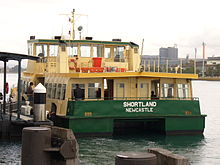
Westbus was an Australian bus and coach operator that operated bus services in Western Sydney from 1955 until October 2013. Founded by the Bosnjak family, it later became a subsidiary of National Express and later ComfortDelGro Cabcharge.
The Urban Transit Authority, a former statutory authority of the Government of New South Wales, was responsible for the operation and maintenance of buses and ferries in Sydney and Newcastle from July 1980 until January 1989.

Hillsbus was an Australian bus company that operated services in the Hills District of Sydney. Founded in 2004 when National Express merged its Glenorie Bus Company and Westbus subsidiaries, it was later part of ComfortDelGro Australia. In early 2023, the Hillsbus brand was replaced by ComfortDelGro's CDC NSW brand.
The Liverpool–Parramatta T-way is a continuous series of bus-only lanes and bus roadways between Parramatta and Liverpool in Western Sydney. Completed in February 2003, the 31 km (19.3 mi) T-way was the first bus rapid transit infrastructure to be built in Sydney.

Transdev Shorelink was an Australian bus company operating services in the northern suburbs of Sydney. It was a division of Transdev. In 2013, Transdev Shorelink was absorbed into Transdev NSW. Rebranding into Transdev NSW did not happen until 2014.

Meadowbank ferry wharf is located on the northern side of the Parramatta River serving the Sydney suburb of Meadowbank.

Buses account for close to six per cent of trips each day in the city of Sydney, New South Wales, Australia, forming a key part of the city's public transport system. The network initially evolved from a privately operated system of feeder services to railway stations in the outer suburbs, and a publicly operated network of bus services introduced to replace trams in the inner suburbs. The bus network has undergone major reforms since the 2000s–2010s, with the New South Wales Government taking responsibility for route and fare-setting, opening contracts for most routes up to competitive tendering, and introducing more cross-suburban services.

Transdev NSW was a bus operator in the northern, southern and western suburbs of Sydney, Australia. It was a subsidiary of Transdev.

Busabout Sydney was a bus company that operated route bus services in South West Sydney, Australia. It operated on behalf of Transport for NSW.

Busways is an Australian bus company operating services in Sydney, and in the Central Coast, Mid North Coast regions of New South Wales and Adelaide. It is the largest privately owned bus operator in Australia.

Newcastle Buses & Ferries was a commuter bus and ferry service operating in Newcastle and Lake Macquarie from 1935 until 2017. Part of the State Transit Authority, it operated 26 bus routes and the Stockton ferry across the Hunter River.

Parramatta ferry wharf is located near the source of the Parramatta River, serving the Sydney satellite city of Parramatta.
The Sydney Metropolitan Bus Service Contracts are contracts issued by the Government of New South Wales to metropolitan bus operators in Sydney, Australia, to operate its public bus route network. Since 2005, the government has moved from individual contracts with operators to larger contract regions, leading to the consolidation of bus operators.

Metrobus is a high frequency, high capacity bus network in Sydney, Australia, first introduced in 2008. Metrobus services run every 10 minutes during peak periods, 15 minutes during off-peak weekday periods, and 20 minutes on weekends, linking key commercial suburbs and centres throughout the city, with the intention of making timetables obsolete. All buses were initially painted in a distinctive red livery but recently, the standard Transport for NSW livery of blue and white has been adopted. All Metrobus services are wheelchair accessible. All route numbers were prefixed with an "M" followed by a two-digit number.

Transit Systems NSW, previously known as Transit Systems Sydney, is a bus operator in Sydney, New South Wales, Australia. It is a subsidiary of Transit Systems.
Transdev Australasia is an operator of bus, ferry, light rail and heavy rail services in Australia and New Zealand. It is a subsidiary of French-based, international Transdev. It was formed in 2013 by grouping the operations of Veolia Transport Australia and former Transdev together, as a result of the global rebranding from Veolia Transdev to Transdev.
The Outer Sydney Metropolitan Bus Service Contracts (OSMBSC) are contracts issued by the Government of New South Wales to bus operators in areas surrounding Sydney. These regions include the Hunter Region, Central Coast, Illawarra and the Blue Mountains. In 2016–17, 21.6 million passenger journeys were made on Outer Metropolitan bus services.
Sydney, Australia is served by a number of bus operators, with Transit systems the largest privately owned operator in New South Wales as of January 2024 when the company took-over Transdev Liverpool, Busabout and Interline. Other major operators include CDC and Busways. Most services are provided as part of the city's integrated public transport system, with routes, fares, service levels, fleet specifications and customer service standards determined by Transport for NSW. A small number of services operate outside of this network.
The Opal card rolled out across New South Wales public transport services from 7 December 2012 until December 2014. Additionally, from December 2017, OpalPay was introduced and can be used as payment on selected third party services. This article contains all the dates of official Opal card and OpalPay rollouts.
Ryde Bus Depot is a bus depot in the Sydney suburb of Ryde operated by Busways.





















